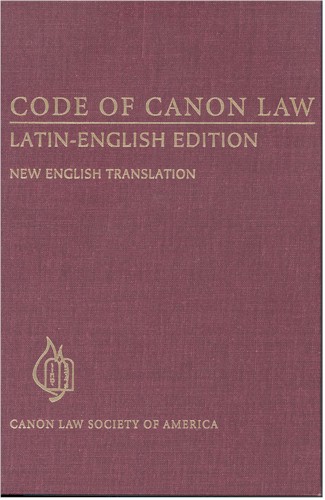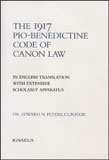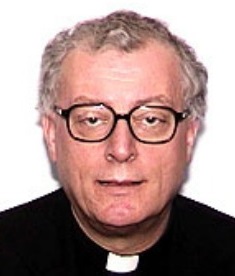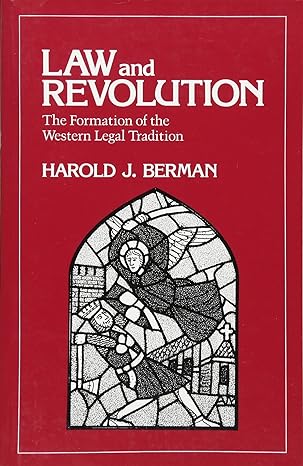|
To work for the proper implementation of canon law is to play an extraordinarily constructive role in continuing the redemptive mission of Christ. Pope John Paul II |
|
20 jun 2024 |
Research links
|
Ius Antiquum, here.
Corpus Iuris Canonici, here.
Gratian, here.
Ius Decretalium, here. |
|
Overview
This page undergoing development. |
Resources in the General History of Canon and Roman Law
Canon law possess a 2000-year history and, drawing as it does upon a legal tradition that reaches back to the Old Testament, and being organized around Roman Law, tracking its history presents a challenge to students and researchers. This page presents basic resources for studying the history of canon law. Some of the works listed here might have been eclipsed by later studies but most are of lasting value and were themselves carefully read and understood by those who later improved on them.
|
|
Basic studies
|
Anyone who knows merely the text of the Code of Canon Law will posses an inadequate knowledge; the whole field of the development of canon law will be a closed book to him. Obviously, ignoring centuries of jurisprudence is not desirable either in the training of a canonist or in his subsequent work. E. Roelker.
• q.v. "Canon Law” and q.v. “Canon Law, History of”
in P. Stravinskas, ed., Our Sunday Visitor’s
Catholic Encyclopedia (OSV, 1991/1998).
▪
Notes: Both entries by E. Peters (unsigned).
• Pietro Gasparri, "Praefatio", available in any monographic printing of the Pio-Benedictine Code; Eng. trans. in Edward Peters, The 1917 or Pio-Benedictine Code in English Translation with Extensive Scholarly Apparatus (Ignatius, 2001) 1-19. • Notes: The first half of Card. Gasparri’s famous Preface brings the reader to the end of the 19th century, while the second half narrates the development of the 1917 Code. On the place of Gasparri in canonistics, see, e.g., G. Osterlé, "Gasparri (Pierre)", DDC V: 939; W. Peters, "Gasparri, Pietro", NCE2 VI: 103-104; and wiki Pietro Gasparri.
|
|
Intermediate studies
Kuttner
|
• A. Boudinhoun, "Law, Canon", CE IX: 56-66, available here; R. Naz, "Droit Canonique", DDC IV: 1446-1495; aa.vv., "Canon Law, History of," NCE III: 34-50; aa.vv., "Canon Law, History of", NCE2 III: 37-58.
• Robert Mortimer (Anglican cleric, 1902-1976), Western Canon Law, (University of California, 1953) 92 pp. ▪ Reviews: E. Roelker in Jurist 14 (1954) 373-374; W. Morris in Journal of Religion 35 (1955) 188, on-line here. Notes: Five classic lectures, only one of which (no. 4) does not call for careful reading and rereading.
• Constant Van de
Wiel (Dutch priest, 1924-2007), History
of Canon Law, (Peeters/Eerdmans, 1991) = pp.
• Review: R. Trupia in
Jurist 52 (1992) 740-741.
Notes: One can (and perhaps should, if a
beginner) skip the introduction and the first chapter (read them
later). Van de Wiel sometimes strays into too much religious order
history but overall this is a solid “first book”.
|
|
Advanced studies
Van Hove
|
• Alphonsus Van Hove (Belgian priest, 1872-1947), Prolegomena ad Codicem iuris canonici [1928], (2d ed., Dessain, 1945) xx-671 pp. ▪ Review: P. Fedele in Ephemerides Iuris Canonici 4 (1948) 473-474. Notes: Magisterial. Editions after the first are greatly expanded and even more valuable. On the place of Van Hove in canonistics see R. Naz, "Van Hove (Alphonse)", DDC VII: 1402-1403; and C. Lefebvre, "Mgr. A. Van Hove", Ephemerides Iuris Canonici 3 (1947) 573-575.
Van Hove, Prolegomena 1: Haec prolegomena ad Codicem juris canonici in quinque partes dividuntur. Prima est de notione iuris canonici; secunda de fontibus constitutivis iuris quo Ecclesia regitur, seu de personis quae in Ecclesia gaudent potestate legislativa; tertia est de fontibus cognitionis seu scientiae iuris canonici, scil. de collectionibus legum ecclesiasticarum; pars quarta exhibet historicum conspectum scientiae canonicae, seu agit de doctoribus et scriptoribus iuris canonici eorumque methodo; pars quinta est de Codice iuris canonici in genere eiusque commentatoribus. (italics original).
|
|
• James Brundage (American scholar, 1929-2021), Medieval Canon Law, (Longman,1995) xii-260 pp. ▪ Reviews: C. Reid in Studia Canonica 32 (1998) 563-565; and K. Christensen in Jurist 56 (1996) 948-949. Notes: Very readable, quite accessible to non-canonists (even those who have not read everything in "General Overviews"), paints an engrossing picture of the practice of canon law in the Middle Ages. Excellent work to introduce longer studies. Good chapters on pre-medieval canon law, too. Consider starting with chapter 4, and saving ch. 2-3 for last. Order Brundage here. wiki James Brundage.
|
|
Robert Kretzschmar, Alger von Lüttichs Traktat 'De misericordia et iustitia, (Jan Thornbecke Verlag Sigmaringen, 1985) =-411 pp. ▪
|
|
Pennington
|
• W. Müller & M. Sommar, eds., Medieval Church Law and the Origins of the Western Legal Tradition: A Tribute to Kenneth Pennington, (Catholic University of America, 2006) xv-404 pp. ISBN-13: 978-0-8132-1462-7. ▪ Review: E. Peters in Journal of Law and Religion 23 (2007) 101-104, here. Notes: 26 scholarly essays in four languages.
• Robert Somerville (American scholar, 1940-) & Bruce Basington, Prefaces to Canon Law Books in Latin Christianity: Selected translations, 500-1245, (Yale, 1998) viii-247 pp., hereafter, Somerville and Basington, Prefaces. ▪ Reviews: A. Thompson in Studia Canonica 33 (1999) 564-566; C. Reid in Jurist 59 (1999) 291-295. Notes: A second edition appeared in 2016.
• J. Sweeney and S. Chodorow, eds., Popes, Teachers, and Canon Law in the Middle Ages, (Cornell, 1989) xiii-342 pp. ▪ Review: =
• Elizabeth Vodola (American scholar, =), Excommunication in the Middle Ages, (Berkeley, 1986) =-281 pp. ▪ Review: E. McDonough in Jurist 46 (1986) 687-688. Notes: Excellent.
• Wolfgang Müller, HugucCio: The Life, Works, and Thought of a Twelfth-Century Jurist, (Catholic University of America, 1994) =-220 pp. ▪ Review: C. Reid in Jurist 55 (1995) 401-403.
• Harold Berman (American scholar, 1918-2007), Law and Revolution: The Formation of the Western Legal Tradition (Harvard, 1983) =-674 pp. ▪ Reviews: Berman's book was quite widely and very positively reviewed. Of special interest to canonists would be, however, the negative review by J. Soria in Studia Canonica 28 (1994) 487-515 and the rebuff of Soria's review by C. Reid in Studia Canonica 29 (1995) 433-480. wiki Harold J. Berman.
|
|
Roman legal history is a vast field and an amateur such as I cannot adequately present it. I can however give some indication of the works I found useful toward my owns studies in a service to my main goal of understanding canon law better.
Legista sine canonibus parum valet, canonista sine legibus nihil. Not sure I quite agree, mind, but I know what it's getting at.
Albert Gauthier (1933-), Roman Law and its Contribution to the Development of Canon Law (University of St. Paul, 1996) 169 pp., and Gauthier, Droit Romain • Albert Gauthier (1933-), Le Droit Romain et son apport à l'édifiction du Droit Canonique (Université Saint-Paul, 1996) 169 pp. Review: C. Reid, Studia Canonica 31 (1997) 272-273. Also available in English.
T. Mommsen, et al., The Digest of Justinian, Latin-English text in 4 vols., (University of Pennsylvania, 1985). See my Corpus Iuris Civilis of Justinian, here.
Adolphe Berger, Encyclopedic Dictionary of Roman Law (American Philosophical Society, 1954) 808 pp. Review: M. McGuire in Seminar (The Jurist) 10 (1952) 85-88.
Andrew Borkowski, Textbook on Roman Law (Blackstone, =).
William Buckland (1859-1946), A Textbook of Roman Law from Augustus to Justinian [1921], (2 ed, Cambridge,1932), 763 pp.
W. Buckland and Arnold McNair, Roman and Common Law, (Cambridge, 1936) 354 pp. Review: P. Ciprotti, Apollinaris 11 (1938) 595-596.
Herbert Jolowicz (1890-1954), Historical Introduction to the Study of Roman Law [1939] (Cambridge, 2008) 556 pp. Order here. See also S. Kuttner, "In memoriam: Herbert Felix Jolowicz", Seminar (The Jurist) 12 (1954) 1-6.
Barry Nicholas, An Introduction to Roman Law (Oxford Clarendon, 1962) 281 pp. Order here.
Fritz Schultz, Classical Roman Law (Oxford Clarendon, 1951/1954) 649 pp. Review: A. Berger, Seminar (The Jurist) 10 (1952) 93-97.
See John Merryman , The Civil Law Tradition: an introduction to the legal systems of western Europe and Latin America [1969], 3rd ed. (Stanford University, 2006) 168 pp. Order here.
Ochoa-Diez, Indices Titulorum • X. Ochoa & A. Diez, Indices Titulorum et Legum Corporis Iuris Civilis (Commentarium pro Religiosis, 1965). Review: B. Deutsch, The Jurist 26 (1966) 265-266.
|
|
Note on the major periods of canon law
|
I propose rethinking the traditional division of the ages of canon law.
In his preface to the 1917 Code, Gasparri writes: Quo in genere, nemo sane ignorat, leges, quae ante Gratianum (intra ann. 1140-1150) latae sunt, ius antiquum, nostra quoque aetate, appellari; quae a Gratiano ad Concilium Tridentinum (ann. 1545-1563), ius novum, etsi iam nobis antiquissimae sunt; quae denique post Tridentinam Synodum, ius novissimum. Gasparri, Praefatio [CIC] ¶ 2. In other words Gasparri proposes a linear, three-stage history for canon law: a period of Ancient Law followed by a New Law ending in a Newest Law.
Gasparri's expertise in the history of canon law notwithstanding, in this one regard, I think that his admiration for the substance of Tridentine legislation led him to over-estimate that council's importance for the fundamental development of the canonical system itself (as opposed to the content of that system). Consequently, Gasparri under-appreciated, I fear, the central role that Gregorian decretal law, specifically the Quinque Libri Decretalium , played in re-organizing canonistics itself three centuries before Trent and for three-and-a-half after.
Consider: during the first millennium of Church history (i.e., during the Ius Antiquum), all agree that canon law operated in a recognizable, if amorphous manner. With the appearance of Gratian's Concordia, all agree, canon law entered into a new kind of activity and Gasparri, in common with other canonists, held that the publication of Gratian's Concordia (now recognized as the first part of the Corpus Iuris Canonici) inaugurated this so-called Ius Novum.
But here is where my proposal begins to differs from Gasparri's time-line.
Gasparri held that this was the way of
doing canon law, until the Council of Trent (1545-1563), at which point, he asserted, canon law entered the Ius Novissimum phase, a period that ran until the advent of codified law in 1917.
The problem with Gasparri's timeline, however, and its disregard for the Decretals of Gregory IX and focus on the Council of Trent, is that, the Council of Trent, though a tremendous source of canonical legislation, did not change how canon law was actually done in the Church. Instead, the promulgation of Gregory's decretals had already, some three hundred years earlier, significantly changed how canon law was done and it was its method of turning to officially collected law that was observed in the Church until the advent of confided canon law in the twentieth century. To be sure, the appearance of Gregory's decretals did not obviate the need for consultation with Gratian's work, and commentary on it continued for some time after the publication of the Libri Quinque Decretalium, but once Gregory's decretals were promulgated, the primary referent, its fons essendi as well as it fons cognoscendi, in canon law was his work, not Gratian's, and it remained that way until the twentieth century.
I suggest, therefore, a modification of Gasparri's timeline. Whereas Gasparri suggests a neat, linear sequence in the development of canon law:
I suggest that the following sequence more accurately, if less tidily, reflects what actually happened in canonistics:
|
|||||||||||||||||||||||
|
|
|
||||||||||||||||||||||||||||||||||||||||||||||||||||||||||||||||||||||||||||||||||||||||||||||||||||||||||||||||||||||||
|
User notes |
There might be editions of works that pre-date or post-date those cited herein. Reviews and Notes are grey-highlighted, on-line biographical information is underlined blue-linked, and matters in green highlights are of special interest. Yellow highlights are cautions for users, while the markers "=", "≠", and "≈" are placeholders for use by webmaster. |
|
Abbreviations on this page might include: |
AAS CCC CLD CLSA Comm. |
Acta Apostolicae Sedis (1909 et seq.) Catechism of the Catholic Church (1997) Canon Law Digest (beginning 1933) Canon Law Society of America Commentary (≠ Communicationes) |
DDC DMC NCE NCE2 QLD |
Dictionnaire de Droit Canonique (1935-1965) Dictionarium Morale et Canonicum (1962-1968) New Catholic Encyclopedia (1967) New Catholic Encyclopedia, 2° ed. (2003) Quinque Libri Decretalium (1234) |
|
Materials on this website represent the opinions of Dr. Edward Peters and are offered in accord with Canon 212 § 3. This website undergoes continual refinement and development. No warranty of completeness or correctness is made. Dr. Peters' views are not necessarily shared by others in the field nor are they intended as canonical or civil advice.
CanonLaw.info Homepage & Site Directory / Help support CanonLaw.info / Original Materials © Edward N. Peters |

















